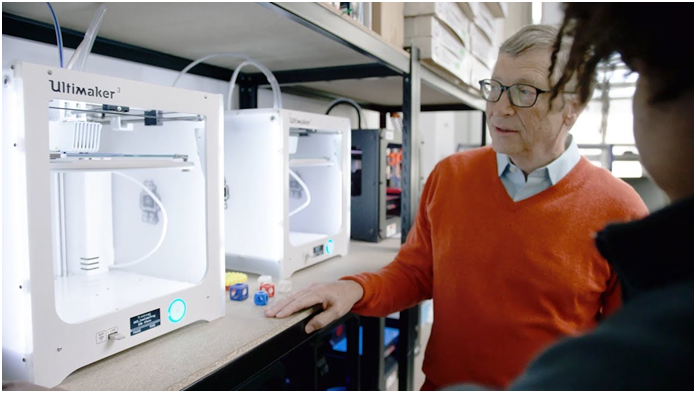
Charles Goulding Jr. takes a trip through Bill Gates’ brain – and finds plenty of 3D printing.
Bill’s Brain
A new film paints a fascinating portrait of Microsoft founder Bill Gates. Inside Bill’s Brain shows an individual constantly consuming and synthesizing ideas, often applying them in unusual ways to solve problems and to innovate.
Two of Gates’ main focuses have become climate change and global poverty. As the film states, these issues likely require “a thousand crazy ideas,” before they can be adequately solved.
One of those crazy ideas is to use 3D printing. Indeed, toward the middle of the documentary, Gates confers with an engineer about 3D printing’s usefulness with respect to climate change.
Below is more explanation of how 3D printing impacts the fields Gates now devotes his life to.
Education
Famously, Gates was a college dropout. On his blog, however, Gates notes his lifelong enjoyment of computer science, a passion first instilled in him in high school.
Gates likens that inspiration to the education students at a Manhattan high school receive thanks, in part, to 3D printing. On a post titled “How 3D printers are preparing students for life after high school,” Gates notes:
“I had the opportunity to sit in one of the design classes offered to upperclassmen. The teacher divided the students into small groups and asked them to create a holder for their headphones. Using modeling software and a 3D printer, they had to design a project that considered function, durability, and user friendliness.”
Gates also financially supports 3D printing and other classroom technologies by matching relevant donations from DonorsChoose.
Global Development
Gates has spent considerable time and resources addressing the needs of the developing world. A major focus has been sanitation, with Gates and his partner Melinda Gates both having been personally moved by the lack of good sanitation systems in one-third of the developing world.
Gates has looked to technology to address the issue, spearheading R&D for toilets that can independently manage waste and treat water without connecting to a communal treatment facility.
Gates is likewise optimistic about how 3D printing can advance the global south. Specifically, he believes the developing world suffers from a problem of duplicative effort. Gates thinks 3D printing can change that. As an article promoted by Gates indicates:
“Now, with affordable 3D printers on sale, widespread internet access and the open-source movement gaining followers, more people can use, study, copy and change a design for free – and share the improvements online….”
Gates’ partner in these efforts, his wife Melinda, is equally hopeful about what 3D printing can do for the developing world. In 2018, she launched an international commission to spawn new technology programs in the global south, including robotics and 3D printing-focused initiatives.
Carbon Capture
In the early 2000s, Gates looked with dismay at projected increases in emissions. He concluded that clean energy alone — intermittent and in need of massive amounts of battery storage — cannot keep atmospheric carbon within acceptable levels. His solution was carbon capture, a controversial technology that some feel only delays the adoption of clean energy solutions.
Gates has disagreed for over a decade, helping to fund a carbon capture firm called Carbon Engineering. Not long after that venture began in 2009, one of the first direct air capture plants in the world became operational, extracting a ton of carbon dioxide daily.
With the concept proven, the issue now is scale and efficiency. That’s where 3D printing recently came into play when scientists at Oak Ridge National Laboratory made a major breakthrough: a custom cooling device implanted in absorption columns that greatly enhances process efficiency.
With innovations like this, 3D printing could become something Gates draws upon heavily to meet his carton capture goals. Indeed, in the documentary mentioned above, an engineer explains to Gates what 3D printing can do for energy efficiency, noting, “today we’re super excited to show you how 3D printing can dramatically improve the energy efficiency of manufacturing.”
Nuclear Power
“I wouldn’t be doing it if it wasn’t for climate change,” Gates says in the documentary. Gates then explains one of nuclear power’s primary challenges: safety. However, Gates feels that next-generation nuclear plants — smaller and more advanced than their predecessors — address waste and safety while providing material benefit to the climate.
Consequently, Gates helped found TerraPower, a firm that now plans to install small, advanced nuclear technology across the United States. To address waste and safety issues, the TerraPower plants use low-enriched uranium, believed to be far safer than uranium used by prior generations of plants.
As with carbon capture, the Oak Ridge National Laboratory (ORNL) sees an important role for 3D printing in nuclear energy. In fact, the ORNL recently succeeded in 3D printing an entire core reactor itself. If printed core reactors can be scaled up, Gates’ interest in 3D printing may find another key application.
Conclusion
Both Gates and the 3D printing industry are now looking for ways to scale up (for more on this in the 3D printing space, see Stratasys’ acquisition of Origin). As Bill’s Brain keeps working toward solutions at scale for both global poverty and climate change, look for him to lean on 3D printing capabilities to do so.
